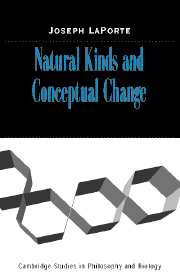Book contents
- Frontmatter
- Contents
- Preface
- Introduction
- 1 What Is a Natural Kind, and Do Biological Taxa Qualify?
- 2 Natural Kinds, Rigidity, and Essence
- 3 Biological Kind Term Reference and the Discovery of Essence
- 4 Chemical Kind Term Reference and the Discovery of Essence
- 5 Linguistic Change and Incommensurability
- 6 Meaning Change, Theory Change, and Analyticity
- Notes
- References
- Index
2 - Natural Kinds, Rigidity, and Essence
Published online by Cambridge University Press: 10 December 2009
- Frontmatter
- Contents
- Preface
- Introduction
- 1 What Is a Natural Kind, and Do Biological Taxa Qualify?
- 2 Natural Kinds, Rigidity, and Essence
- 3 Biological Kind Term Reference and the Discovery of Essence
- 4 Chemical Kind Term Reference and the Discovery of Essence
- 5 Linguistic Change and Incommensurability
- 6 Meaning Change, Theory Change, and Analyticity
- Notes
- References
- Index
Summary
In chapter 1, I argued that ‘water’, ‘horse’, and ‘mammal’ are natural-kind terms. Along the way I argued briefly that biological kinds have theoretically interesting essential properties, or properties that they possess necessarily and not just contingently. It is time for a more thorough look at necessity in connection with kinds. That is the task of the present chapter.
Although I will be taking a close look at essences, I will postpone a serious look at whether scientists' conclusions about essences are empirical discoveries, as they are commonly thought to be. A serious treatment of that issue, and surrounding issues about conceptual change in science and philosophy, will have to wait for the chapters following this one. For now, I will address just the issue of whether interesting statements about natural kinds are indeed necessarily true, not whether they have been discovered to be so.
My answer, as I have already indicated, will be that at least some interesting statements about natural kinds do indeed seem to be necessarily true. In section (I), I discuss identity statements. I clarify and defend the position that natural-kind terms are rigid designators, so that some statements of identity about natural kinds are necessarily true. In section (II), I discuss whether individuals essentially belong to the kinds to which they belong and whether narrower kinds essentially belong to the broader kinds to which they belong – for example, whether Tabby the tiger essentially belongs to Panthera tigris, and whether the species Panthera tigris itself essentially belongs to the broader kinds Mammalia, Chordata, and so on. I follow these sections with a brief conclusion.
- Type
- Chapter
- Information
- Natural Kinds and Conceptual Change , pp. 33 - 62Publisher: Cambridge University PressPrint publication year: 2003



